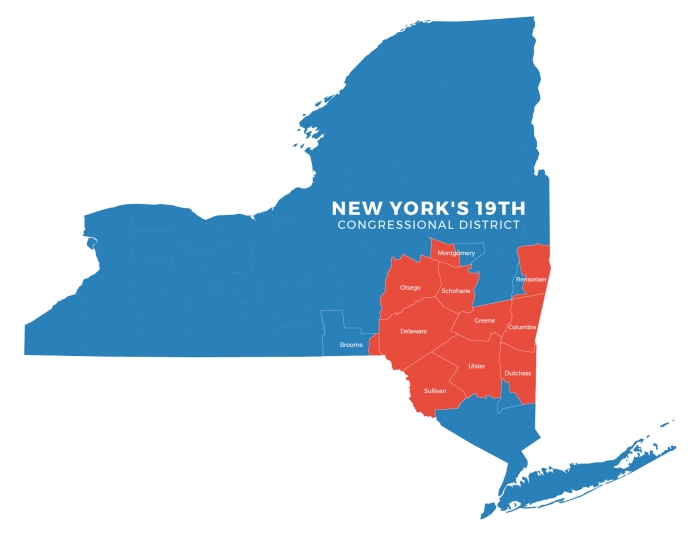The “Blue Wave” hit the 19th District in the 2018 midterms — hard.
Antonio Delgado’s victory in the midterms was helped by a surge of voter participation, with the number of voters turning out in some parts of the 19th District looking more like a presidential election.
This increase in voting numbers went to the Democrat, as John Faso saw his votes decrease from his Republican predecessor’s despite the overall surge.
This is the “Blue Wave” many have talked about in the run-up to the elections: a significant increase in democratic votes spurred by liberal concerns about he direction of the country.
An analysis of numbers from the New York State Board of Elections and county boards of elections in the district shows 29 percent more total votes were cast this midterm than the last, in 2014. Dutchess County saw the highest leap, with 40 percent more total votes, followed by 38 percent in Ulster County, and 29 percent in Sullivan County.
Every other county in the district also saw rises in their voter participation, ranging from 15-25 percent.
Delgado beat Faso by 7,593 votes, 49.3 percent-46.4 percent. Green Party candidate Steve Greenfield received 4,037 votes, or 1.5 percent, while independent candidate Diane Neal got 2,619 votes, slightly less than 1 percent.
Sixty percent of active registered voters in the district cast ballots for the midterms, compared to less than 46 percent during the last midterm election in 2014, when incumbent Republican Chris Gibson slew democrat Sean Eldridge in a landslide.
Midterm elections tend to have drastically lower voter participation than Presidential elections, but this midterm, buoyed by Democratic concerns about healthcare and the Trump presidency, saw participation rates closer to the 2016 Presidential election.
In fact, only 14 percent less people voted in the midterm than did for congressional candidates in 2016, when the Trump-Hillary matchup brought voters to the polls
Though voter participation across the board rose by 29 percent from 2014’s midterms, less people voted for Republican John Faso this year than Republican Chris Gibson in 2014. In other words, all these extra votes went to Delgado, and Faso saw a drop in votes from his republican predecessor.
In Columbia County, the most liberal and most conservative municipalities both saw significantly more overall votes than in 2014, but less votes for the Republican candidate, according to an analysis of county board of elections figures.
In Hudson, which had the highest percentage of Hillary voters in 2016, 39 percent more residents voted this midterm than in 2014. The number of people voting for Delgado nearly doubled from the number of people voting for Eldridge in 2014, and the number of people voting for the Republican candidate fell by 40 percent.
In Stockport, which had the lowest percentage of Hillary votes in Columbia County, the number of total voters rose by 24 percent from 2014. Delgado received more than double the votes Eldridge did in 2014, but the votes cast for Faso fell by more than 10 percent when compared with Gibson’s numbers in 2014.
In other words, in both Hudson and Stockport, all the additional votes went to Delgado — plus hundreds more.
Overall, Ulster County, the most populous county in the district, favored Delgado most heavily, with 59 percent voting for Delgado, compared to 37 percent for Faso. Columbia and Dutchess counties also went for Delgado, while the rest of the counties in the district favored Faso.
All three of the Delgado-voting counties favored Chris Gibson in 2014.





The difference between Gibson and Faso was vast. Gibson was about the closest thing we get anymore to a centrist Republican, so he drew a fair number of votes from across the aisle. Faso by contrast alienated even the middle-of-the-road voters by the racist tenor of his campaign advertising.